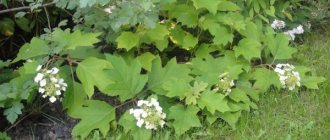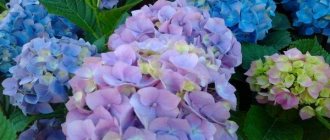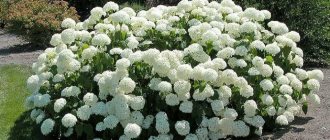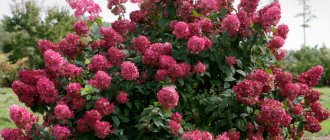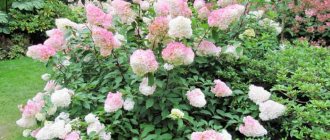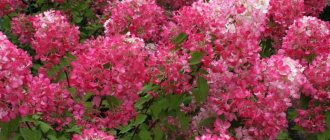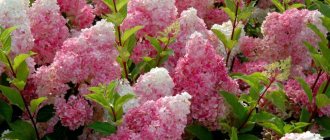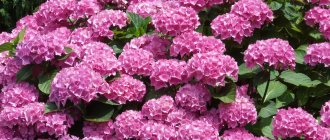Plants » Flowers
0
466
Article rating
Kira Stoletova
Serrata hydrangea (Hydrangea serrata) captivates with its bright inflorescences and the ability to change color depending on the composition of the soil. She needs regular care, but it is not particularly difficult. This shrub is grown in regions with warm and temperate climates, providing shelter and insulation for the winter.
Serrated hydrangea varieties photo
Description
Hydrangea serrata (adapted Latin name) is a compact bush 1–1.5 m high. The central trunk is usually thick and branched. Strong shoots grow at a slight upward angle, forming a dense, rounded crown. The bark is gray-brown, greenish on young branches.
Did you know? During archaeological excavations in Alaska, in North America, fossilized particles of hydrangea were found. After analysis, scientists came to the conclusion that the plant grew here more than ten thousand years ago.
Hydrangea serrata or, more correctly, serratifolia is a densely foliated plant. The leaves are medium to large in size, 7–11 cm in length, depending on the variety. The plates are oval with a pointed end and a wide base, mottled with wrinkles. The edge of the leaf is edged with well-defined serrations. Color ranges from light to dark green.
Flowering period: June – September. Inflorescences are spherical or in the form of corymbs. The petals are wavy along the edge. Color ranges from pink and blue to lilac. The flowers cover the bush so thickly that often the foliage underneath is not visible.
Timing for pruning shrub hydrangeas
In order for garden hydrangeas blooming on the current year's shoots to bloom luxuriantly, they need to be pruned early.
Pruning should be done as early as possible to allow as much time as possible for flowering growth to develop. Despite the fact that large-leaved hydrangea blooms on last year's growth, pruning for it is also carried out in the spring, as early as possible. But its character is radically different from pruning other bush hydrangeas.
For hydrangeas that need winter cover, pruning is often postponed until the fall. But before sheltering, it is better to shorten the shoots only as lightly as possible, and repeat full pruning in the spring.
Components of pruning hydrangeas:
- sanitary cutting, or cleaning - removal of old, damaged, weak, dry shoots, last year's inflorescences;
- formation - pruning aimed at regulating the density and shape of the crown, in young plants - the formation of skeletal branches;
- stimulating or regulating pruning - annual pruning aimed at obtaining more powerful flowering;
- radical rejuvenation - radical pruning, which is carried out instead of the other three components on old, neglected, depressed hydrangea bushes.
Popular varieties
Most serrated garden forms were developed in Japan. The varieties are mostly winter-hardy, have immunity against diseases, and are rarely attacked by insects. Serrated hydrangea can be grown in open ground conditions in the middle zone, in the Moscow region, in the Urals and in Siberia. In cold regions, it is advisable to provide crops with shelter.
Bluebird
The height of the bush is no more than 1.2 m, the crown can grow up to 1.5 m. The finely serrated leaves are oval in shape. The color of the plates is bright green. The inflorescences are collected in corymbs with a diameter of 10 cm. The flowers are small in the center, with larger baskets located along the edges. The time for buds to open is July. Bright blue or purple caps remain on the bush until September. Bluebird calmly survives the winter with temperatures dropping to -20°C.
Oamaha
The compact shrub grows up to 1.5 m, while the crown reaches no more than 60 cm in diameter. Oamaha is a large-leaved variety; the length of the leaf can be equal to the size of the inflorescences - 9–12 cm. The green leaves are oval in shape with an elongated sharp end.
The inflorescences are umbrella-shaped, the color depends on the type of flower:
- sterile - blue or pink;
- fertile ones are blue or white.
The flowering period is from June to September.
Important! Soil acidity can change the color of the petals: acidic soil is blue, neutral soil is pale blue, alkaline soil is purple.
Koreana
Large flower baskets can be pink, blue and blue, and on one bush at the same time. The inflorescences are umbellate, densely sprinkle the bush in early July and decorate it until September. Plant height - 1.5 m, crown width - 1.2 m. Foliage with a wide plate of medium size, 7–9 cm in length.
Preciosa
The variety is no more than a meter high. The crown is round and dense. Preziosa produces yellow-green buds at the beginning of flowering. As the petals bloom, they turn pink. And then purple or lilac. Flowering time begins in the second half of July and continues until September inclusive. The variety has high winter hardiness and can be grown in cold regions.
Virl
Giant among other varieties: reaches 2 m in height. Whirl has low growth power. An adult specimen grows a crown 1.5 m wide. It blooms all summer. Purchased flowers are collected in round inflorescences. Petals with a pink or blue tint.
Rough hydrangea (Hydrangea aspera)
Hydrangea rough variety Peter Chapell
A beautiful species with large inflorescences up to 25 cm in diameter forms a shrub or small tree 3-4 m high. The stems are covered with light pubescence, the hairs are tightly pressed to the base. The inflorescences are corymbose, dense, violet-purple in color with white, pink or bluish sterile flowers. Varietal plants have very attractive flowers, fringed or with jagged edges of the petals.
Frost resistance is below average; the shrub requires good cover of the root system, freezing to the level of snow.
Popular varieties of rough hydrangea:
- Peter Chapell;
- Anthony Brillivant;
- Velvet Lace.
Landing
It is recommended to purchase seedlings from nurseries. When purchasing, you need to inspect the bush. Good planting material has developed shoots with buds, a flexible and moist root system. The soil clod of a seedling with closed roots should not emit an unpleasant odor. To make sure of this, carefully dump the bush out of the container.
Site selection and soil preparation
For a serrated look, you need to choose a flat place, without slopes or holes. The root system of hydrangea is not located deep from the surface, only 40–55 cm, so the bush may not survive on hilly areas, especially if it is strewn with heavy inflorescences.
Check out
Features of planting hydrangeas in open ground
Moisture, rain and melt water accumulate in the lowlands. The plant loves moisture in moderate portions, but not in excess. Diffused lighting is recommended: the shadow will make the inflorescences loose, and too bright and aggressive sunlight will burn the delicate petals and foliage.
The site is dug up and a mineral complex is introduced into the ground:
- urea - 20 g;
- potassium salt - 20 g;
- superphosphate - 25 g.
During digging, all plant debris from last year should be removed.
Landing dates
Planting dates depend on the region where the crop is grown. In the southern regions, planting is possible in the fall, after the heat has subsided and 1.5–2 months before frost. In the central and northern regions, planting is carried out in the spring. It could be April or May. The main condition is that the earth must be warmed up to at least +8°C.
Step-by-step instruction
When planting a group of plants, leave a gap of up to one and a half meters between them. The size of the pit is 50x50x60 cm.
Planting pattern:
- The soil removed from the hole is mixed with peat and sand in a ratio of 2:1:1.
- Some of it is poured onto pre-made drainage made of crushed stone or gravel in a layer of 15 cm.
- A seedling is placed on top and the roots are straightened.
- When the plant is covered with soil, monitor the position of the growth point - 3–5 cm above the ground level.
- Afterwards, watering is carried out using a bucket of water.
The tree trunk circle is covered with a layer of mulch of 6–8 cm. Material - peat, sawdust, tree bark.
Transplantation into open ground
To plant a plant in open ground, you will need to prepare a soil composition of fertile humus, rotted leaves, peat and sand in a ratio of 2:2:1:1. Holes for planting should be dug in advance; their depth should be about 35 centimeters. The distance between plants should be at least one meter. The landing procedure itself is quite simple:
- The pre-dug hole is carefully spilled with water.
- The shoot intended for planting is carefully placed in it.
- The landing site is covered with earth.
- The soil around the plant is compacted.
- The hydrangea seedling is watered abundantly.
- Mulch the planting with sawdust or pine needles to a height of 10 cm.
Care
Hydrangea is generally not a whimsical plant. But you need to monitor the soil moisture to prevent the roots from drying out. The plant also requires nutrients and shelter from overheating. No less important is timely pruning, especially sanitary and formative.
Fertilizer
The plant responds well to root and foliar feeding. You should not overdo it with nitrogen, so that the growth of leaf mass does not come at the expense of flowering.
Important! Before adding dry preparations, you need to moisten the soil, otherwise you can burn the roots.
For shrubs, several feedings per season are enough:
- In early spring, foliage growth is stimulated by adding an infusion of bird droppings. The product is diluted with water in a ratio of 1:20.
- When buds begin to form, potassium and phosphorus are needed. To prepare root feeding, you need potassium salt and superphosphate, 30 g/10 l of water.
- During flowering, repeat the previous option, adding 2 g of boric acid to the product.
- The last fertilizer is applied at the end of August. Place 50 g of superphosphate and potassium salt into the soil around the tree trunk.
Watering
The description of the species speaks of the plant’s love of moisture. A short-term drought will not lead to death, but will worsen the quality of flowering. Settled water is used for irrigation; chlorine has a bad effect on plants. An adult bush will need 2-3 buckets of water. A young specimen needs 10 liters of liquid. With frequent precipitation, the frequency of soil irrigation should be reduced: due to excess moisture, the roots will begin to rot.
Read how to properly care for hydrangea in the garden.
Trimming and shaping
In the spring, when inspecting the bush, you should remove weak and broken shoots. Some may be damaged by wind, snow crust, and they are also pruned. To form a beautiful crown, leave the strongest and most even branches. This way they create a backbone. Next, shoots that grow inward and are unpromising are removed from the ring.
Every year the shape is maintained by trimming branches that stick out from the general contour of the crown. Rejuvenating cutting for varieties with fast growth is carried out once every 2-3 years, for slow-growing varieties - once every 5-7 years. The shoots are simply removed onto the stump.
Winter hardiness and shelter for the winter
Serrata hydrangea is resistant to low temperatures; many varieties can withstand -25...-30°C.
Young bushes in cold regions need careful preparation for winter:
- Mulch from sawdust or tree bark in a layer of 25 cm.
- Installation of a circular support on which the agricultural material is pulled.
- Spruce branches and snow crust when snow falls.
It is enough to mulch adult bushes. If the crop grows in an open area, it is advisable to tie the branches with twine so that they are not broken by the wind and the weight of the fallen snow.
Read more about the rules for covering hydrangeas for the winter.
Wintering
The winter hardiness of Hydrangea serrata increases over the years. All young shrubs , without exception, must take shelter for the winter .
Hydrangea feels more comfortable in the southern winter; it will be extremely difficult . climate of central Russia with winter temperatures not lower than -25°C is suitable
Preparations for wintering begin in mid-September. First you need to trim the old branches and remove dried, unfallen leaves. Before covering, the hydrangea needs to be fed with phosphorus-potassium fertilizer.
Ways to cover for the winter:
- Hill up high and cover with a plastic bag - winters down to -5°C.
- Tie the bush with rope. Hill up high and sprinkle with sawdust and spruce branches. Cover the top with several layers of plastic film and secure with wooden boards. This method will help you survive winter down to -15° .
- Trim dry shoots as much as possible. Select bunches of 1-2 branches, bend them to the ground and secure with wooden brackets. Cover the bush with sawdust, spruce branches, dry leaves, and cover with a sheepskin coat or an old blanket. Lay several layers of polyethylene on top, secure with boards or bricks. The method is suitable for winters -15 – -20°C .
Important! For maximum insulation, use a metal mesh frame, which can be covered with old clothes on top. You can cover the structure with bricks instead of a mesh. Such structures are also suitable at -30°.
Diseases and pests
Proper and attentive care will protect the crop from diseases and pest attacks.
And yet you should familiarize yourself with the methods of dealing with possible misfortunes:
- With fungal diseases such as powdery mildew, septoria, the biological fungicide “Gamair” does an excellent job. The solution for spraying the bush is prepared in the proportion of 2 tablets/10 liters of water.
- Root rot and tracheomycosis can be combated using another biological agent - Alirin-B. A working infusion for watering the tree trunk and foliage is made from 2 tablets and 10 liters of water, stirring thoroughly.
- “Akarin” is effective against leaf-sucking and leaf-eating insects ( aphids , thrips , mites The bush should be sprayed with a solution in the proportion of 2–6 ml/1 liter of water.
- Soil pests (weevil, slugs) are vulnerable to the active ingredient of the Apache insecticide. To water the bush, you need to dissolve 1 g of the product in a liter of water.
To prevent harmful insects from annoying the area, flower growers plant repellents next to ornamental crops. These plants repel almost all garden pests with a pungent odor.
Reproduction options
Flowers of serrated species consist of sterile and fertile flowers, so they can reproduce by seed. It is better to buy seeds from trusted sellers. They should be dried before planting. In addition, the method of cuttings and layering is very successful and simple.
Learn in more detail the best methods and timing for propagating hydrangeas.
Seeds
Sowing is carried out in February. A few days before, the seeds are placed in damp cotton wool to swell. Sow the material in wet sand, covering the container or pot with glass. For several weeks, every 2–3 days the seedlings are sprayed and condensation is removed from the glass. When sprouts appear, the cover is removed. With the appearance of the first pair of strong leaves, the seedlings dive into separate containers.
The substrate is taken as for a seedling. Until the plant grows up and forms a strong root system, it is kept in the house, on a lighted windowsill. Care consists of watering and fertilizing. Fertika fertilizer is applied to the soil twice a month, 5 g per pot. In autumn, feeding is stopped until spring. A 2–3-year-old bush is transplanted into open ground.
Read more about how to grow hydrangea from seeds.
By cuttings
Cuttings are taken at the beginning of summer from shoots of the current season. You need a piece of branch 6–8 cm long with 2 internodes and a pair of leaves. Root in wet sand, placing it in the substrate at an angle. The shoot is covered with a piece of plastic bottle. Regularly ventilate and spray the soil every 2-3 days. Next spring, the grown, rooted bush is transplanted to a permanent place.
By layering
Layers can be propagated at any time of the year, except late autumn and winter. You need to choose the longest branch from an adult plant. A narrow groove no more than 15 cm deep is dug under it. Part of the shoot, cleared of foliage, is placed in it.
Did you know? Buddhists have a tradition: on Buddha's birthday, tea from hydrangea leaves, called "amacha", is poured on the head of the statue of the deity in the temple.
The layering is sprinkled with soil, and its upper part is left on the surface. When caring for the mother bush, attention is also paid to the seedling. Next spring, the cuttings with roots are carefully separated from the donor and planted in a permanent place in the garden.
Hydrangea with serrated leaves will adequately decorate any corner of the site. Properly selected varieties and types of crops will turn the garden into a continuously blooming paradise.
Origin
The homeland of serrated hydrangea is Japan. It was from here that the plant was brought to Europe at the very beginning of the 19th century and began to be used to decorate gardens in the houses of the nobility. Initially there were only two types of flowers: scarlet and white.
Serrated hydrangea has a very unusual appearance
Today there are many varieties of shrubs, including hybrid ones. They are available for everyone to plant.
